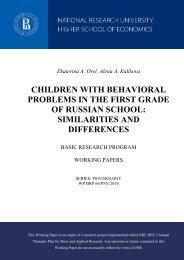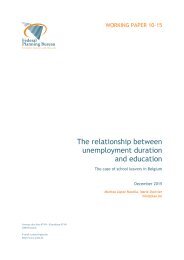Ten-Year Impacts of Burkina Faso’s BRIGHT Program
n?u=RePEc:mpr:mprres:2ecdd42bb503422b802ce20da2bf64b7&r=edu
n?u=RePEc:mpr:mprres:2ecdd42bb503422b802ce20da2bf64b7&r=edu
Create successful ePaper yourself
Turn your PDF publications into a flip-book with our unique Google optimized e-Paper software.
IV: FINDINGS<br />
MATHEMATICA POLICY RESEARCH<br />
D. <strong>Impacts</strong> on child labor<br />
Children who attend school are unable to engage in other activities during the time that they<br />
are in class or studying. One <strong>of</strong> the main opportunity costs is work that the child might otherwise<br />
do for pay or for the family. The 3-year impact evaluation as well as the 7-year impact evaluation<br />
found modest reductions in children’s work (Kazianga et al. 2013, Kazianga et al. 2016). 31 We<br />
assess the impacts <strong>of</strong> the program using the current data set on the same set <strong>of</strong> outcomes, and<br />
present the results in Table IV.4.<br />
The program no longer had any impact on the number <strong>of</strong> children engaged in labor<br />
activities in the past week. Unlike the results observed in the 3-year and 7-year impact<br />
evaluations, we did not find any significant differences in participation in any <strong>of</strong> the children’s<br />
labor activities (Table IV.4, panel A), including a standardized composite work index. 32 The<br />
change is not simply due to aging; the results are similar when we use only children in the same<br />
age group as the 2012 evaluation (6- to 17-years-old). For the 10-year impact evaluation, we also<br />
investigated the impacts on the hours children engaged in labor activities. Children in both<br />
selected and unselected villages spent the most amount <strong>of</strong> time in fetching water—about 4<br />
hours—and tending animal—about 3 and a half hours—in the week before the survey, but they<br />
also spent 1 to 2 hours in other household labor activities. However, we found no significant<br />
impacts <strong>of</strong> the <strong>BRIGHT</strong> program on time spent on child labor activities as well (Table IV.4,<br />
panel B).<br />
There are two reasons that may have contributed to the lack <strong>of</strong> impacts on child labor. First,<br />
the smaller impact on enrollment in the current data has likely resulted in a smaller difference<br />
between the selected and the unselected villages in the number <strong>of</strong> children engaged in labor<br />
activities. Second, the drop in the impact <strong>of</strong> <strong>BRIGHT</strong> may also be the result <strong>of</strong> broader societal<br />
changes in the way child labor is viewed. There was a decline in participation across all <strong>of</strong> the<br />
labor activities from 2012 to 2015 in both selected and unselected villages, more so in unselected<br />
villages (for example, percentage engaged in collecting firewood declined by 3.5 and 8.7<br />
percentage points from 2012 to 2015 in selected and unselected villages, respectively). This may<br />
have resulted from the recent efforts by the Government <strong>of</strong> <strong>Burkina</strong> Faso to reduce the<br />
prevalence <strong>of</strong> child labor in <strong>Burkina</strong> Faso (Bureau <strong>of</strong> International Labor Affairs 2015). It is<br />
possible that the efforts were more concentrated in the unselected villages because <strong>of</strong> the higher<br />
prevalence <strong>of</strong> child labor in those area as was seen in the 3-year and 7-year impact evaluation.<br />
31<br />
It should be noted that de Hoop and Rosati (2012) find conflicting results using the same data, arguing that the<br />
program actually increased children’s work in some specifications.<br />
32<br />
The composite work index is constructed in two steps. First, we take the sum <strong>of</strong> seven binary variables that appear<br />
as one if the child had: collected firewood, cleaned, fetched water, cared for siblings, tended animals, shopped, or<br />
done other family work in the previous week. Second, we standardized the sum to express the work index in<br />
standard deviations. Only chores that at least 10 percent <strong>of</strong> children participated in are included.<br />
40







